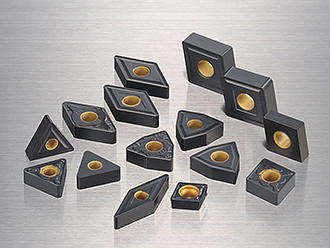Press Release
Sumitomo Electric Launches the New AC4000K Series for Cast Iron Turning
June 14, 2017
Sumitomo Electric Industries, Ltd.
*This press release was originally published in Japanese on April 24, 2017.
Sumitomo Electric Industries, Ltd. has developed the new AC4000K series for improved stability and longer tool life in the turning of gray and ductile cast iron, and launched it in May 2017.

New AC4000K series items
Cast iron can be used to produce complex machine components at relatively low cost, as its strength can be increased by adding additives to change its metal structure. Due to these features, automotive structural parts with complicated shapes, such as sliding parts*1 found in disc brakes that require lubrication and vibration damping properties or gear casing where strength is required, can be made from cast iron.
Gray cast iron*2 is a highly workable material with low impact strength and high thermal conductivity, generally resulting in a long tool life. However in recent years, with the increased demand for high-efficiency machining, suppressing noticeable flank wear even in high-speed machining has become a task for improving tool life.
On the other hand, ductile cast iron,*3 a material with high tensile strength, also poses a problem to cutting tools as it causes the cutting edge to heat up easily and adhere to work pieces, which results in inconsistent tool life.
In response to these challenges, Sumitomo Electric has developed the AC4000K series, which are made from the new grade AC4010K or AC4015K. Although the retail price is set at the same level as existing products, this new series will contribute greatly to lowering overall production costs by providing more stable tool life, thus reducing frequency of tool replacement and improving efficiency, resulting in short machining time.
- 1. Features
-
- AC4010K
A grade with a thick CVD*4 coating with excellent thermal resistance. Utilizing a high-strength, grain-orientation controlled alumina layer and new surface treatment to provide exceptional wear resistance, this grade suppresses chipping and tool fracture.
In addition, higher adhesion strength between the CVD layer and substrate provides twice as much resistance against peeling than conventional grades. AC4010K is capable of withstanding high cutting speeds of up to Vc = 700 m/min in the machining of gray cast iron. - AC4015K
A general purpose CVD-coated grade with outstanding stability. Like AC4010K, AC4015K also adopts the newly developed high coating adhesion technology, giving it improved resistance to coating peel-off caused by work adhesion. When used in machining where the coating layer is likely to peel off, its improved coating adhesion gives cutting edges twice the stability of conventional coating layers. The first recommendation grade for cast iron turning.
- AC4010K
- 2. Lineup
-
Negative type insert series 392 items Positive type insert series 96 items Total 488 items - 3. Sales Plan
¥100 million in the first year
¥300 million a year after 3 years
(AC4010K and AC4015K combined)- 4. Pricing
-
Set at the same level as equivalent conventional products
(Standard item) CNMG120408N-GZ-----¥770 (¥832 including tax)
*1 Sliding parts:
Parts within machinery that rub against each other.
*2 Gray cast iron:
Cast iron refers to an alloy whose base components are primarily carbon (C) and silicon (Si), where the carbon content is 2.1% or higher. Gray cast iron is a type of cast iron consisting of carbon that is more graphite than cementite, resulting in a gray-colored fracture surface.
*3 Ductile cast iron:
A type of cast iron that has slightly higher carbon and silicon contents than gray cast iron. Its graphite structure is spheroidized by adding magnesium and cerium.
*4 CVD (chemical vapor deposition):
A method for forming a coating layer through vapor deposition on the surface of the substrate material that has been heated within a reaction chamber. Raw material gases containing components of the coating are fed into the chamber, where they will chemically react and form the coating.


